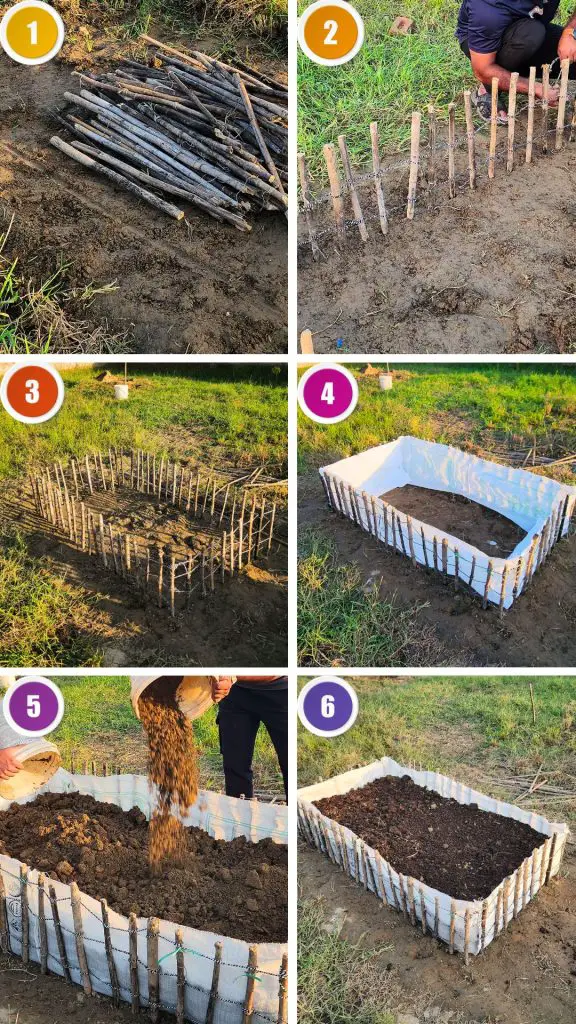Building a raised bed garden doesn’t have to be expensive or complicated. With a bit of creativity and the use of old, recycled materials, you can create a productive and eco-friendly garden space right in your backyard. This guide will take you step by step through the process, explaining everything from selecting the location to understanding the benefits of using recycled materials.

Choosing the Right Spot for Your Raised Bed
The first and most important step in creating a raised bed garden is choosing the right location. Plants need plenty of sunlight, so find an open area that receives at least five to six hours of sunlight every day. Avoid shaded corners under large trees or near tall walls that block light. A flat area with good air circulation is ideal.
When you have selected the spot, mark the shape and size of your raised bed. You can use a stick or shovel to draw a line on the ground. The shape can be circular, rectangular, or square depending on your space and preference. Make sure the bed is wide enough to grow several plants but not so wide that you cannot reach the center for watering or harvesting. A typical width of three to four feet works perfectly for most home gardens.
Using Bamboo and Rope for the Frame
Instead of buying new wooden planks or metal frames, you can easily build the walls of your raised bed using old bamboo branches. Bamboo is strong, durable, and lightweight, making it an excellent material for garden use. If you have bamboo pieces that were used as trellises or supports in previous seasons, they can be repurposed for this project.
Start by placing bamboo sticks along the line you marked earlier. To fix them into the soil, gently push each piece into the ground. If the soil is too hard, use a stone or small hammer to tap the ends of the bamboo until they stand firmly. Space the sticks evenly to form a clean boundary for your bed. Once the shape is complete, take a piece of old rope and tie the bamboo pieces together tightly. This helps the structure stay stable and prevents the sticks from spreading apart when you fill the bed with soil later. Using rope also gives your garden bed a rustic, natural look while keeping it secure for a long time.
Lining the Inside with Recycled Materials
After building the bamboo wall, it’s time to line the inside of your bed to hold the soil in place. This step helps prevent soil erosion and keeps everything neat. The best part is that you don’t need to buy anything new for this. You can use old food-grade sacks, such as rice or flour bags, which are usually made of strong plastic or fabric. Cut the sacks open into large sheets and wrap them around the inside of the bamboo structure.
If you don’t have sacks, other good options include old cardboard, tarpaulin, or landscape fabric. Just make sure the material you use is safe for plants and does not contain harmful chemicals. Overlap the edges slightly to avoid gaps where soil might leak out. Once the lining is in place, your raised bed will have a neat inner wall that keeps the soil contained and protected.
Filling the Raised Bed with Soil Layers
Now that the structure is ready, it’s time to fill it with soil. A well-balanced mix of materials will ensure your plants get all the nutrients they need to grow strong and healthy.
For the first layer, add loamy garden soil. Loamy soil is ideal because it contains the perfect mix of sand, silt, and clay, providing both good drainage and moisture retention. If your garden soil is too sandy or too heavy with clay, mix it with compost or old leaf mulch to improve its quality. Spread this soil evenly inside the bed until it fills about three-quarters of the height.
For the second and final layer, add a thick layer of fully decomposed manure or organic compost. This acts as the nutrient powerhouse for your plants. Manure can come from cows, goats, or even kitchen compost that has completely broken down into dark, crumbly soil. This organic matter releases nutrients slowly over time, feeding your plants naturally and keeping the soil healthy.
Once both layers are added, lightly mix the top few inches to blend the manure and soil together. Your raised bed is now filled and ready for planting.
Planting in the Raised Bed
After the bed is filled, you can begin planting immediately. Because of the rich soil and excellent drainage, a wide variety of plants can thrive in raised beds. You can grow vegetables like tomatoes, peppers, cucumbers, spinach, lettuce, or carrots. Herbs such as basil, coriander, and mint also do extremely well.
When planting, space the seeds or seedlings properly to allow enough room for each plant to grow. Water the bed thoroughly after planting, and keep it slightly moist in the following days to help the roots establish themselves. If you live in a hot region, adding a layer of mulch on top can help retain moisture and reduce the need for frequent watering.
Advantages of Building a Raised Bed with Recycled Materials
There are many reasons why building a raised bed from recycled materials is such a smart and rewarding choice.
One of the biggest advantages is cost. You can create an entire raised garden bed without buying anything new. Old bamboo, used ropes, and worn-out sacks are often available at home or can be easily found in your surroundings. This saves you money while reducing waste and helping the environment.
Raised beds are also great for improving soil quality. Because you fill them yourself, you can control what kind of soil and fertilizer go inside. This means healthier plants, stronger roots, and better harvests. The soil in raised beds is loose and airy, allowing roots to spread easily and draw nutrients efficiently.
Another benefit is better drainage. After heavy rainfall or watering, raised beds prevent water from pooling around the plants, which protects them from rot and fungal diseases. The soil also warms up faster in early spring, giving your plants a head start compared to ground-level gardens.
Raised beds are easier to maintain too. Since the soil surface is elevated, you don’t have to bend too low when watering, weeding, or harvesting. This makes gardening much more comfortable, especially for people with back problems or limited mobility.
Weed control is another major benefit. Because you start with clean, fresh soil and lined sides, very few weeds will appear inside. Even if they do, the loose soil makes it easy to pull them out by hand.
Using recycled materials also promotes sustainability. Instead of throwing away old bamboo or sacks, you give them a new purpose. Over time, the natural materials like bamboo will decompose and enrich the soil further, adding organic matter and improving fertility.
